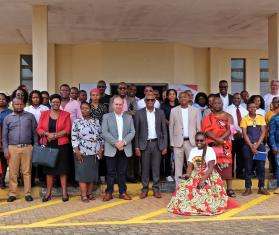Governments meeting at the World Health Organization’s Executive Board this week must seize the opportunity to improve serious shortcomings in the document that will drive the global community’s vaccines response for the next decade

Sierra Leone 2012 © Lynsey Addario/VII
Mothers await vaccinations for their children at the Bumpe Government Clinic in Bo District.
Geneva/New York, January 24, 2013—Governments meeting at the World Health Organization’s Executive Board this week must seize the opportunity to improve serious shortcomings in the document that will drive the global community’s vaccines response for the next decade, said the international medical humanitarian organization Doctors Without Borders/Médecins Sans Frontières (MSF). If they fail to do so, some of the key reasons for why millions of children continue to die of vaccine preventable causes will be left unaddressed.
Vaccines: A Preventable Fate, by Venetia Dearden
Countries will decide how to assess the success and steer the activities of the "Global Vaccine Action Plan," a $50-billion vaccine initiative for the developing world. Although the high price of some vaccines threatens many countries’ abilities to sustain its vaccine programs, the Vaccine Action Plan so far does not include any measures to monitor or control prices.
“The cost of vaccinating a child has risen by 2,700 percent over the last decade, so it is puzzling that the vaccines blueprint for the next decade does not have a goal to bring prices down,” said Dr. Manica Balasegaram, executive director of MSF’s Access Campaign. “Governments in countries where we work are increasingly worried about how they will foot the bill for vaccines when donor support tapers off.”
In 2001, the cost of vaccinating a child was US$1.37 for the basic vaccines package for TB (BGC), polio, diphtheria, tetanus, pertussis, and measles. With the addition of more vaccines, and particularly two new vaccines against pneumococcal disease and rotavirus—which together account for nearly 75 percent of the cost of vaccinating a child—the cost per child has risen to $38.80 at best, with many countries paying much higher prices. As of 2016, officially 16 countries are scheduled to “graduate” from GAVI Alliance support, losing the substantial GAVI subsidies that have helped those countries pay for the introduction of the newest available vaccines.
“Much more attention needs to be paid to getting vaccine prices down, for example by speeding up the market entry of emerging producers which would foster competition,” said Balasegaram. “The ‘Decade of Vaccines’ is expected to cost around $50 billion, and the cost of the vaccines themselves will swallow a large chunk of that money. Simply ignoring this fact is not acceptable.”
Equally alarming is the action plan’s lack of ambition when it comes to tackling the fact that many vaccines are ill-suited for use in developing countries today. Over the last five years, 112 million children did not even receive the basic vaccine package to protect them from childhood killers, in large part because today’s vaccines are difficult to use in remote or rural areas (e.g. they must be kept cold, require trained health workers to administer injections, or must be given in multiple doses requiring several clinic visits).
Despite the urgency of the need, the action plan has an unambitious goal of only one new adapted vaccination technology in use by 2020, even though several new technologies to deliver vaccines—for example, in a needle-free way (through a mask or with air pressure)—are on the cusp of receiving WHO quality approval.
“Even for an organization with the logistical capacity of MSF, vaccinating children in hard-to-reach places, with vaccines that need to be kept cold, is a serious challenge and it means children are falling through the net,” said Kate Elder, vaccines policy advisor for MSF’s Access Campaign. “We need more products that make vaccinating children easier. We need a clear signal that this is a critical objective for the next ten years.”




